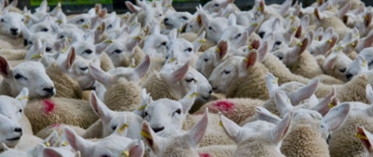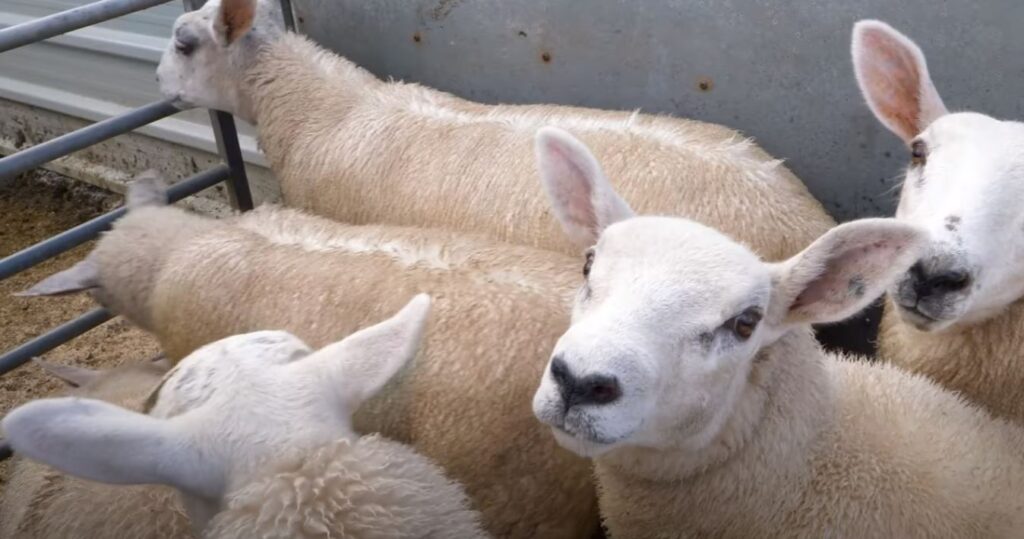Growing and Finishing Lambs in Autumn and Winter
25 October 2023As the year progresses, the days shorten, and the weather turns colder. This reduces the potential to grow good quality and quantities of grass. Depending on farm resources, this may mean that growing lambs start to compete against other enterprises on the farm such as breeding ewes for forage, labour and housing space. If the growing lambs start to compromise the farm system, e.g. forage availability, then a good question to ask is – should they be sold store or finish?
Selling Store or Finish Lambs
It may be financially beneficial to sell lambs store if:
- Land and forage supplies are required by other enterprises e.g. breeding ewes for tupping and winter keep.
- Forage stocks are low.
- Purchased inputs (e.g. concentrate feeding) are not at an economically viable value.
- There is no building space available to house if required.
- Labour is limited or required for other enterprises.
To ensure a good return on lambs being sold store, they must be healthy and well grown, meaning good flock management should be performed for their lifetime e.g. parasite control, lameness prevention, trace elements and vaccinations given. Lambs should ideally be batched by their weight. This will ensure finished lambs are of an even batch to secure premium prices and store lambs receive tailored nutrition.

An example of sorting lambs to weight is shown in this table.
| Weight | Time to Finish | |
|---|---|---|
| Short Keep | Over 35kg | 4 - 6 weeks |
| Medium Keep | 30 - 35kg | 6 - 12 weeks |
| Long Keep | Under 30kg | Over 12 weeks |

Profitability
For every day a lamb is on a farm, they are a cost to the system. The profitability of a finishing system relies on excellent flock management, nutrition, understanding the market and a low use of inputs.
Maintaining and monitoring a budget and performance is useful when finishing lambs. This allows information to be analysed and any weaknesses in the system highlighted. A simple budget is presented here.
| Per head | 100 head | |
|---|---|---|
| Selling Price | £107 | £10,700 |
| Total Income | £107 | £10,700 |
| Less Buying Price of Lamb | £57.00 | £5,700 |
| Less Feed (concentrate) | £3.60 | £360 |
| Less Vet and Medicines | £3.66 | £366 |
| Less Commission, levies, haulage, shearing, tags | £9.55 | £955 |
| Cost of Forage (swedes) | £3.85 | £385 |
| Cost of Forage (silage) | £2.14 | £214 |
| Total Variable Cost | £79.80 | £7,980 |
| GROSS MARGIN | £27.20/lamb | |
Maintaining a record of additional costs to the system, such as deaths, daily live weights, concentrate use, etc. Allows for a data set to see any trends, where improvements can be made to further assist productivity. An example of this would be the flock above may have a high death rate of 8% of lambs (target 4%). Meaning a potential loss in sale of the animals, while still having the costs associated of £79.80 x 8 lambs = £638.40, reducing the profit average to £18.64/lamb from £27.20/lamb.
Feed Conversion
Lambs are more efficient at converting food to meat when they are younger, with a Feed Conversion Ratio (FCR) of 3:1 or 4:1 up to weaning, meaning for every 4kg eaten, 1kg of weight is gained. As the lamb gets older, its feed conversion efficiency reduces with figures of 6:1 to 10:1 being suggested. Grass is the cheapest feed that can be offered to lambs, therefore this should be maximised through managing grazing heights throughout the summer and autumn period. Grass is only cost effective when it is of good quality and achieving good growth rates, as shown in the table below.
| Expected Daily Live Weight Gain | |
|---|---|
| Short Leafy Swards | 150 - 200 g/day |
| Mature Stemmy Swards | 50 – 60 g/day |
| Brassica and Root Crops | 150 – 250 g/day |
A target for lowland farms should be to finish 80% of lambs off grass. To achieve this, animals should be regularly weighed and growth rates monitored. This grass based system vastly reduces the cost and reliance on inputs such as concentrate feeding.
Supplementary Feeding
Batching lambs on short, medium and long keep allows for tailored nutrition for the performance required for the animals.
Expected daily live weight gain (g/day) for short, medium, and long keep finishing lambs.
| Time to Finish | |||||
|---|---|---|---|---|---|
| Target Weight | 3 Months | 5 Months | 7 Months | 9 Months | 11 Months |
| 42 kg | 416 | 250 | 178 | 139 | 114 |
| 44 kg | 438 | 263 | 188 | 146 | 120 |
When grass growth becomes limited in the autumn and winter, the addition of concentrate may be required for short keep lambs at grass. The best response of this is when grass is below 4 cm in height. This addition allows for lamb growth rate to be maintained when grass growth slows down, as well as adding fat to leaner lambs for marketing.
Concentrate feeding can be purchased as a compound or pellet, or alternatively, some choose to create a home mix. A lamb feed should have a minimum Metabolise Energy (ME) of 12.5 MJ/kg DM, crude protein (CP) of between 14-16% as fed. It should also be mineralised with an inclusion of 0.5% (5000 mg/kg) ammonium chloride and low magnesium to reduce the risk of urinary calculi in castrated males.
When formulating a home mix, it is important to ensure it is well balanced with sufficient protein and energy to meet the growing lamb's needs. Due to the high levels of cereals included in home mixes as an energy source, there is an increased risk of acidosis and urinary calculi. In order to mitigate this risk the following steps should be considered:
- Do not over process grain (whole or a light crack is sufficient).
- Urea and enzyme treatment of cereal will increase pH reducing acidosis risk (30% lift in protein also reduces protein inclusion required).
- Mineralise with an intensive lamb mineral (including ammonium chloride).
- Consider the inclusion of a rumen buffer such as sodium bicarbonate.
- Ensure sufficient fibre in the ration (forage, whole oats, beet pulp or soya hulls).
- Ensure a good supply of clean fresh water.
Example home mix rations using urea and enzyme treated and untreated barley.
| Feed | Untreated | Treated |
|---|---|---|
| Barley (kg) | 650 | 725 |
| Beet Pulp (kg) | 100 | 100 |
| Rapeseed Meal (kg) | 225 | 150 |
| Intensive Lamb Mineral (kg) | 25 | 25 |
| ME (MJ/Kg DM) | 12.5 | 12.5 |
| Crude Protein (% as fed) | 15.0 | 15.0 |
For more information on grain treatment - fas.scot/downloads/treatments-to-grain-for-feeding-ruminants/
Concentrate feeds should be introduced to lambs gradually over a period of time to prevent upsets to the rumen. Initially starting with trough feeding, ensuring that all lambs have access and are eating feed before introducing hoppers for ad lib concentrate feeding. Minimum feed space allowance as per Red Tractor guidelines are:
| Ration Fed Concentrates | Ad-Lib Concentrates |
|---|---|
| 30 cm | 10 - 15 cm |
Once lambs are safely transitioned onto hoppers, they will eat up to 1 kg/head per day depending on forage availability and bodyweight.
When lambs are in outdoor finishing systems, it is vitally important to ensure they have both shelter and somewhere dry to lie. Continuous wet and windy weather requires a higher level of energy for maintenance and their growth rate can be negatively affected. Housing may be beneficial in scenarios such as this.
Indoor Systems
Indoor finishing lamb systems are typically used for older lambs, on an intensive ad lib concentrate and forage diet (straw or hay).
Buildings should be well ventilated and dry, with a good access to water for the lambs.
Indoor finishing systems can be expensive compared to forage systems. Health conditions such as foot rot may be more prevalent in an indoor system, to minimise this adequate straw should always be provided and any problems treated and removed to isolation swiftly.
Health
A health plan should be created with a local vet for growing and finishing lamb systems. This should include key topics such as quarantine, internal and external parasites, lameness control, clostridial infections, and mineral and trace element deficiencies.
Top Tips
- Batch lambs by weight to maximise returns on feed.
- Introduce supplementary feeding when the grass is below 4 cm.
- Any feeds should be made of good quality ingredients and 12.5 MJ/kg DM of metabolise energy and 14-16% protein.
- Add 0.5% ammonium chloride to prevent urinary calculi in castrated males.
- Introduce feed gradually and ensure there is adequate trough space.
Related Resources
Kirsten Williams, SAC Consulting
Lorna Shaw, SAC Consulting
Sign up to the FAS newsletter
Receive updates on news, events and publications from Scotland’s Farm Advisory Service

